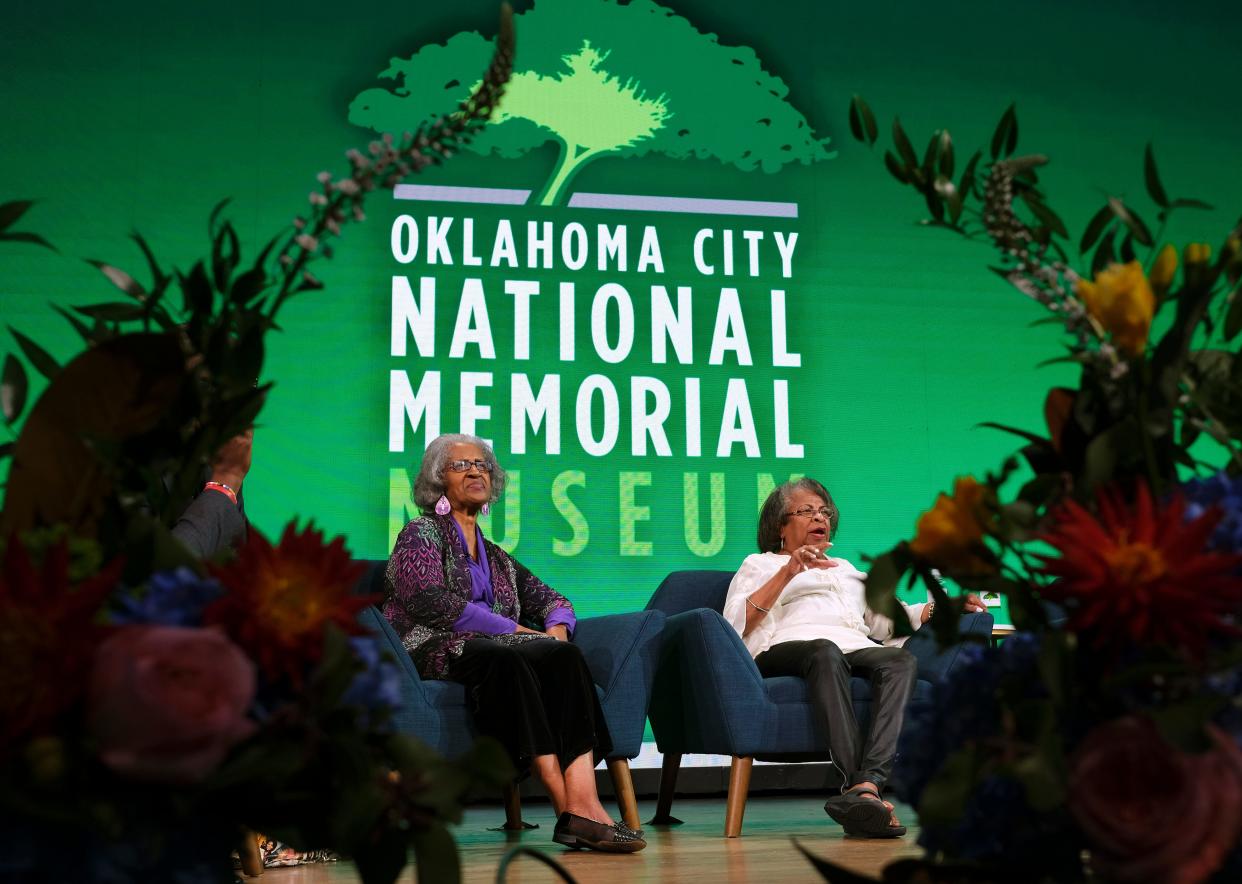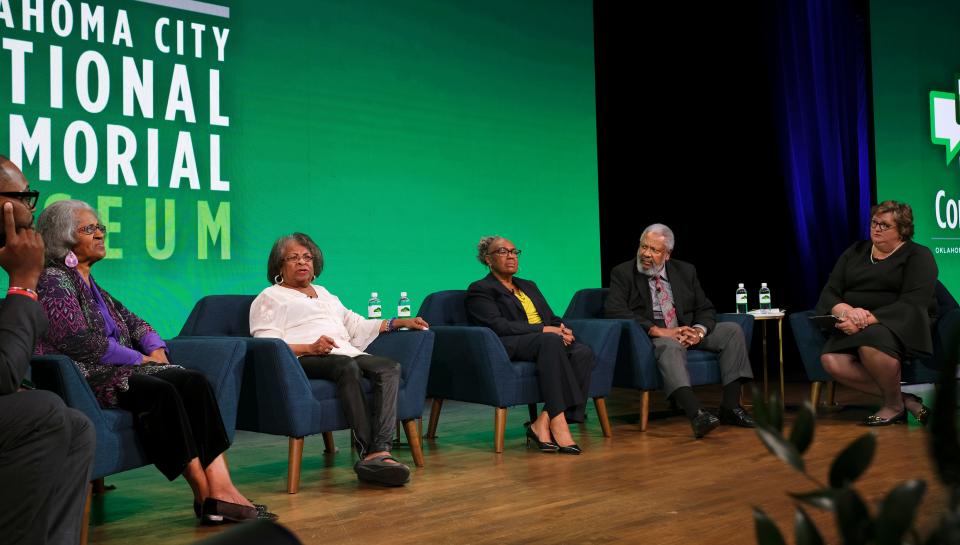'Failure was not an option.' Activists discuss sit-ins at OKC bombing memorial lunch

- Oops!Something went wrong.Please try again later.
Hundreds of Oklahomans on Wednesday marked two moments in time ― one distinguished by nonviolence and community transformation and one steeped in violence and heartbreaking tragedy.
Four participants of the successful Oklahoma City sit-in movement to integrate Jim Crow era establishments were guest speakers at the Oklahoma City National Memorial & Museum's Day One Luncheon. The event, held at the National Cowboy & Western Heritage Museum, marked the beginning of 168 Days of Remembrance leading up to April 19, 2023, and the 28th anniversary of the Oklahoma City bombing, which left 168 people dead.
Kari Watkins, Oklahoma City National Memorial & Museum's president and chief executive officer, said there were valuable lessons to be learned from the sit-in participants and the movement that changed Oklahoma City for the better. What better way to begin the days leading up to the bombing anniversary than by educating and reminding people about the community transformation — grounded in the principles of faith and nonviolence ― that took place in the 1950s and 1960s.
More: Kanye West's antisemitic comments at odds with his Oklahoma family's civil rights legacy
"I think we've all gotten a little bit better in the last couple years of getting this story out there, but we felt like there was a great opportunity, a great audience of Oklahoma City people, that would help take this story and share it and teach it to the next generation," Watkins said Wednesday.
The luncheon's panel discussion was patterned after the Oklahoma City National Memorial's Better Conversations initiative, which is designed to bring people together to talk about important issues ― offering opportunities for dialogue in a world where division and isolation have become prevalent. John Kennedy, memorial museum executive committee board chairman, told the estimated crowd of 450 that the sit-in participants took a path of nonviolence just a few blocks and 37 years from the place and time where the Oklahoma City bombing occurred.
"They are truly heroes," he said. "They have changed our country and our community."
The sit-in participants sat on stage and answered questions from Watkins and Karlos Hill, regents' professor of African and African American studies at the University of Oklahoma and a member of the Clara Luper Legacy Committee. The four sit-inners recalled the days when they were part of the NAACP Youth Council led by the group's beloved adviser and educator, Clara Luper. Thirteen members of the youth council started the sit-in movement by sitting at the lunch counter at whites-only Katz Drug Store and ordering Coca-Colas on Aug. 19, 1958.

Notably, one of the speakers was Marilyn Hildreth, 75, Luper's daughter who came up with the idea for that first sit-in. Other speakers on Wednesday included Joyce Henderson, 75; Joyce Jackson, 78; and Larry Jeffries, 76.
Hildreth said she and the other young activists were frustrated that they could spend their money at segregated downtown Oklahoma City establishments but were forced to get their food from brown bags at the back door of restaurants instead of dining inside. She said they could only go to the zoo on Tuesdays, and they couldn't live in certain parts of the city "all because of one thing ― our skin was black."
The quartet of activists said they did not feel fear, though Jackson said her parents were concerned about the youths being harmed by angry whites.
Hildreth said the young people simply wanted the discrimination to end. Though people spat, coughed and poured coffee on them, they persevered, and on the third day, Katz became an integrated establishment by serving the African American youths.
"We could not understand how grown people could be so mean to kids ... so we continued to sit," Hildreth said. "We didn't want our city to be like that. We wanted our city, Oklahoma City, to be open to everybody. Failure was not an option."
The group also talked about Luper's leadership.
Jackson said she begged her parents to allow her to be part of the sit-in movement. They relented eventually because they trusted Luper with their daughter. Jackson said she was proud to be among the sit-inners who were taken to jail during the protests. Henderson drew laughter when she said she missed an opportunity to be taken to jail with her fellow activists because she went to the restroom.
"I wanted to be with the rest of the group," she said.
Hildreth said she and the other young activists did not encounter the kind of violence that news outlets reported about in other places across the nation. She said she felt that was largely due to the city police force's understanding that the youths had a right to protest, and her mother told her later that the young people were "surrounded by angels" in the form of many Oklahoma City residents who believed in their cause.
"The leadership in Oklahoma City is why we didn't have the violence, I really believe," Hildreth said.
When Watkins asked each sit-inner to share their advice for the audience, Jeffries urged everyone to exercise their right to vote "to make your voice heard loud and clear." Henderson said people should strive to be the best at whatever they do and always move forward. And Hildreth advised the crowd "Don't give up."
Remembrance and education
The Oklahoma City National Memorial & Museum was created to honor “those who were killed, those whosurvived and those changed forever” by the 1995 bombing of the Alfred P. Murrah Federal Building inOklahoma City. The Memorial and Museum are dedicated to educating visitors about the impact of violenceand terrorism, informing about events surrounding the bombing, and inspiring hope and healing throughlessons learned by those affected.
Dr. Susan Chambers, vice chair of the Oklahoma City Memorial & Museum Foundation's executive committee, said Wednesday was the nonprofit's annual Giving Day, providing potential donors with a 24-hour opportunity to raise funds to sustain the memorial and museum's mission. She said the memorial and museum receives no annual federal, state or local government funding.
Meanwhile, Watkins told Hildreth and the other activists that their civil rights work reminded her of the Oklahoma City National Memorial & Museum's six grounding virtues: words matter, humility, generous listening, hospitality, patience and adventurous civility.
"You guys are amazing," she said. "Your story is important for us to learn and an important story for the memorial to tell through our Better Conversations."
This article originally appeared on Oklahoman: Activists discuss OKC's history of civil rights sit-ins, OKC bombing

